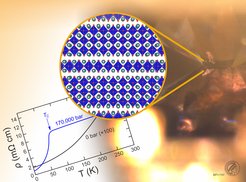Revealing Hidden Layers in Superconducting Nickelates
In a collaborative effort, researchers from the Max Planck Institute for Solid State Research (MPI-FKF) have discovered a new crystal structure in La₃Ni₂O₇, a material known to exhibit high-temperature superconductivity under high pressure.
Superconductors, which are materials that carry electrical current without energy loss, offer vast opportunities for technological advances in energy transmission and medical devices. Recently, superconductivity was discovered under high pressure in the nickel-based material La₃Ni₂O₇, with a remarkably high transition temperature of 80 kelvin (K), just above the point at which nitrogen liquefies (77 K). However, the microscopic mechanism driving the superconductivity in the material remains a subject of ongoing debate. In a joint effort, researchers from the Solid State Spectroscopy Department, Crystal Growth Scientific Facility (CGSF), Quantum Materials Department, and the Stuttgart Center for Electron Microscopy (StEM) at MPI-FKF, alongside collaborators from several partner institutions, uncovered a surprisingly distinct crystal structure of La₃Ni₂O₇.

Detailed scanning transmission electron microscopy (STEM) investigations at MPI-FKF and single-crystal x-ray diffraction (XRD) experiments at the European Synchrotron Radiation Facility (ESRF) in Grenoble, France, revealed that La₃Ni₂O₇ single crystals grown at the CGSF consist of alternating monolayers and trilayers of NiO₆ octahedra. In addition, electronic transport measurements performed under high-pressure conditions in diamond anvil cells in the Quantum Materials Department showed that these crystals undergo a filamentary superconducting transition around 80 K. Notably, while the filamentary nature and transition temperature align with previous observations, earlier studies had assumed a bilayer structure for La₃Ni₂O₇. This new insight into the material's structural arrangement with a complex layering sequence raises important questions about the relationship between its structure and superconducting properties.
To further explore these implications, density functional theory (DFT) calculations were carried out by a team at the Friedrich-Alexander-Universität Erlangen-Nürnberg. The DFT results clarified how the monolayer and trilayer units contribute differently to the material’s electronic properties, providing a firm basis for advanced theoretical modeling and future studies on the nature of superconductivity in layered nickelates and related materials.











